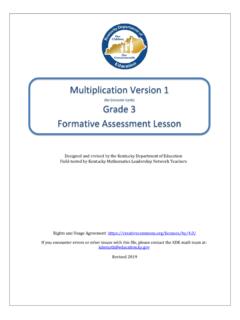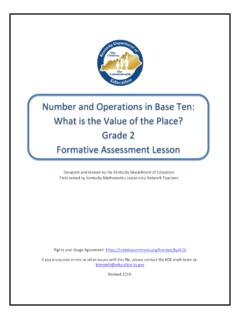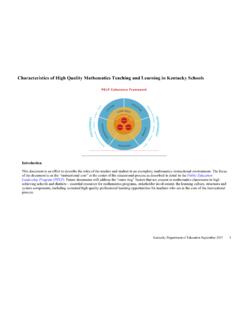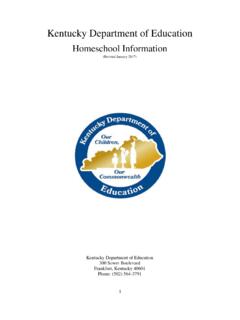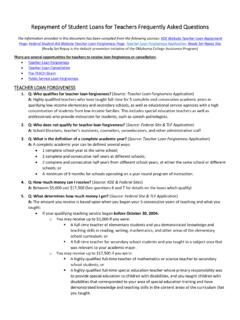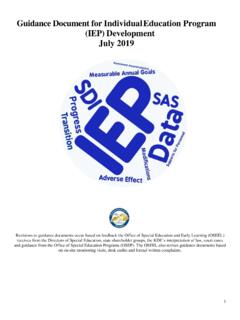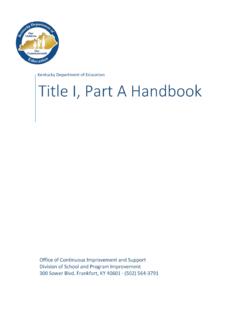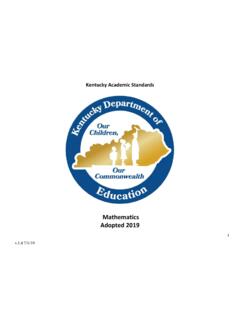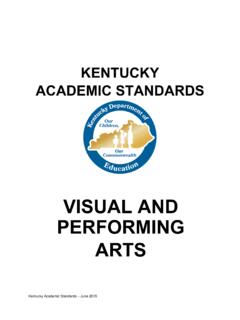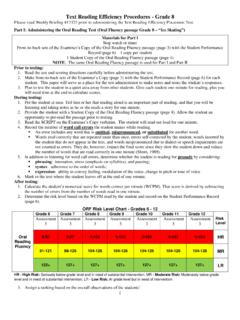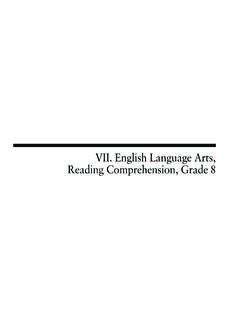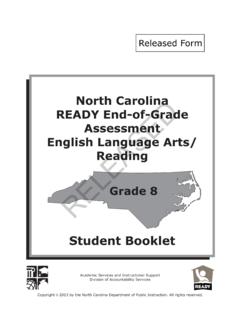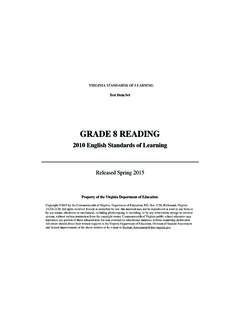Transcription of Grade 8 Reading - education.ky.gov
1 Grade 8 Reading KAS Standard: Determine the meaning of words and phrases as they are used in a text, including figurative and connotative meanings; analyze the impact of specific word choices on meaning and tone, including analogies or allusions to other texts. Reading STANDARDS FOR LITERATURE Accommodations and Supports (Should align with IEP) KAS-KAAP Content Assessment Standard: Determine the meaning of tone and impact of figurative and connotative words and phrases as they are used in text; analyze the tone and impact of analogies in text. What does the student need to know to begin?
2 (pre-requisite skills) 1) understand meaning of figurative language, connotative and technical vocabulary 2) content specific vocabulary prior knowledge of key vocabulary To compare and contrast words and phrases identify vocabulary for figurative language, connotative (feelings or images word evokes) words ( synonyms and antonyms) Identify literal meanings of words distinguish between an informational text and literature. understand compare/contrast and same/different concepts and the relationship between them identify and use context clues What will the student be able to do?
3 (student outcomes) To determine implicit meaning of words as related to tone evoked To identify the writer s attitude ( playful, formal, angry, tender, etc) through words figurative language ( simile, metaphor and hyperbole, personification, irony) used in the text How will you task analyze the skill? How will you teach this? (SDI, strategies) distinguish positive words and negative words using T-chart apply emotions to words ( snake fear; bunny comfort; earthquake fear; gentle rain- soothing) pair multi-sensory activities ( touch, hear, see, smell, & taste) for meanings of words.
4 Use of Frayer model- (concept maps) ( ) using pair words with pictures/photos/objects use of semantic maps What materials will be needed? Grade level adapted text, variety of informational texts ( newspapers, recipe books, magazines, manuals, news 2 you), Frayer model- (concept maps) ( ),Websites Coach, Ladders, Workout What will daily checks for understanding look like (formative assessment)? What were the outcomes of your practice test (summative assessment)? Reflections (what worked well, what will you change next time) Grade 8 Reading KAS Standard: Determine a theme or central idea of a text and analyze its development over the course of the text, including its relationship to the characters, setting, and plot; provide an objective summary of the text.
5 Reading STANDARDS FOR LITERATURE Accommodations and Supports (Should align with IEP) KAS-KAAP Content Assessment Standard: Determine a central idea of text and analyze its relationship to the character, setting, and plot. What does the student need to know to begin? (pre-requisite skills) make initial predictions about the story content specific vocabulary sequencing main events in the story determine relevant information understand literary elements ( character, plot, setting) in a story understand supporting ideas 1) content specific vocabulary 2) sequencing 3) determine relevant information 4) able to summarize What will the student be able to do?
6 (student outcomes) to be able to determine main idea in story to summarize a story Determine how details ( character, plot, & setting) contributed of outcome of story How will you task analyze the skill? How will you teach this? (SDI, strategies) ) use of graphic organizers 2) use of 3-2-1 (or KWL) strategies to determine main idea 3) use of repeated story line, repeated Reading , familiar concepts 4) use of preview text, 5) reduce amount of text, use of paraphrase 6) use priming, explicit teaching ( I do, we do, & you do) 7) use of get the gist strategy What materials will be needed?
7 Grade level adapted text ,visual manipulatives (objects, ),Marzano strategies, Story-based lessons steps, Coach & Ladders books, News to you & Weekly Reader, Appendix B from Common Core Standards document What will daily checks for understanding look like (formative assessment)? What were the outcomes of your practice test (summative assessment)? Reflections (what worked well, what will you change next time) Grade 8 Reading KAS Standard: Determine the meaning of words and phrases as they are used in a text, including figurative, connotative, and technical meanings; analyze the impact of specific word choices on meaning and tone, including analogies or allusions to other texts.
8 Reading STANDARDS FOR INFORMATIONAL TEXT Accommodations and Supports (Should align with IEP) KAS-KAAP Content Assessment Standard: Determine the meaning of tone and impact of figurative, connotative and technical words and phrases as they are used in text; analyze the tone and impact of allusions to other texts. What does the student need to know to begin? (pre-requisite skills) Identify content specific vocabulary (figurative, connotative & technical language) identify vocabulary for figurative language, connotative (feelings or images word evokes) words ( synonyms and antonyms) Identify literal meanings of words Distinguish between an informational text and literature.
9 Identify and use context clues To compare and contrast words and phrases To develop knowledge of figurative, connotative, and technical words and phrases and determine their impact (make something standout or contribute to tone) on text Understand meaning of figurative language, connotative and technical vocabulary What will the student be able to do? (student outcomes) Describe emotions based words in text, Identify allusions (indirect references) and impact to other text How will you task analyze the skill? How will you teach this? (SDI, strategies) Compare/contrast two types of text ( presidential biography vs.)
10 Newspaper article about them), use of graphic organizers, use of semantic maps, pair words with pictures/photos/objects, provide multiple examples (poetry, song lyrics, folk tales, fairy ) What materials will be needed? Grade level adapted text, Coach & Ladders books, Marzano s vocabulary strategies & Thoughtful education strategies to use before-during-after strategies What will daily checks for understanding look like (formative assessment)? What were the outcomes of your practice test (summative assessment)? Reflections (what worked well, what will you change next time) Grade 8 Reading KAS Standard: Determine a central idea of a text and analyze its development over the course of the text, including its relationship to supporting ideas; provide an objective summary of the text.
